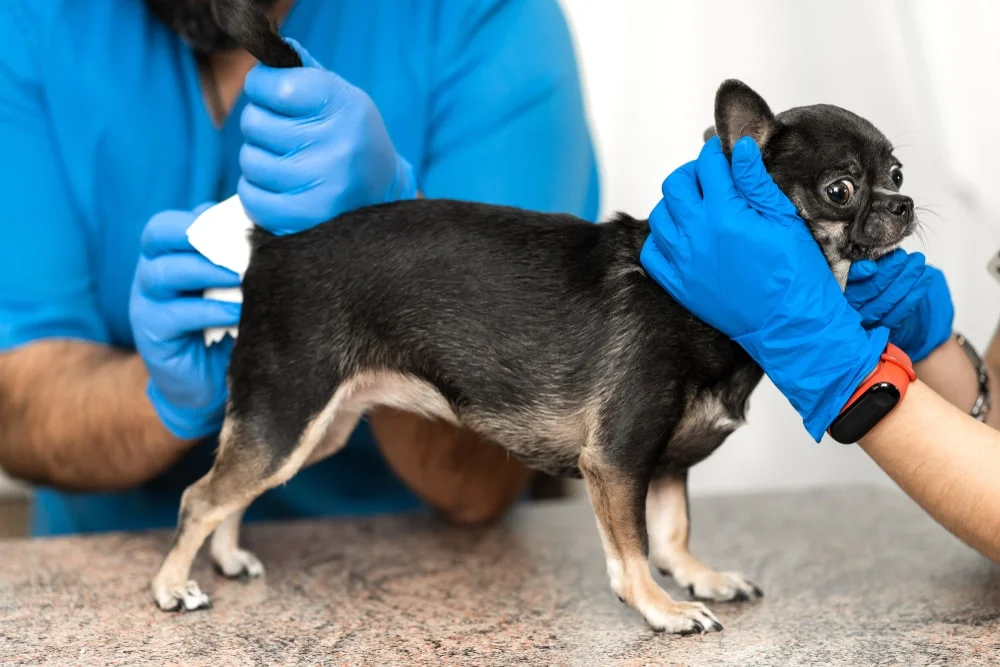PET HEALTH
Anal Glands in Dogs: Issues and Treatments
Have you ever noticed your dog excrete a smelly liquid from their bottom? It likely means they just expressed their anal glands.
Anal gland issues can be common in dogs, but most times they’re easily remedied. Sometimes, however, the anal glands create painful issues for dogs and their owners. Here’s what you should know about anal glands in dogs.
Does Your Dog Have Anal Gland Issues?
What Are Anal Glands in Dogs?
A dog’s anal glands — or anal sacs — are two small pouches on each side of the anus. Each sac is lined by multiple sweat glands that produce anal gland fluid.1
Anal gland fluid is a pungent liquid that’s most often released during a bowel movement. However, some dogs may also express their anal glands when they’re scared or stressed.1
What’s their purpose?
Anal glands in dogs, and the fluid they produce, serve as a way for dogs to mark their territory. It’s similar to what skunks do — and the result can be just as stinky.1
If you’ve ever wondered why dogs seem interested in smelling each other’s bottoms and feces, it’s because anal glands express a unique scent. So when your dog is sniffing, it could help them recognize the smell of a familiar furry friend.1
Types of Anal Gland Issues in Dogs
There are several anal gland problems that might affect your dog, especially smaller dog breeds.2 Most are categorized as anal sac disease, and these anal gland issues can include:1,2
- Swollen anal glands
- Anal gland impaction (being plugged up)
- Ruptured anal glands
- Anal gland infection
- Anal gland abscess (pocket of pus)
- Anal gland cancer (adenocarcinoma)
Anal sac disease happens when anal glands don’t express during defecation, or there’s poor muscle tone around the anus. If the anal gland fluid isn’t released, the anal sacs can become inflamed and infected.2
Signs of Anal Gland Issues
Look for these common signs of anal gland disease in dogs:1,2
- Scooting or dragging their butt
- Discomfort while sitting due to pain
- Excessive licking, biting, or itching near the anal area
- Straining while pooping
- Secretions with blood or pus (which could cause stains on surfaces)
- A “fishy” odor
To properly diagnose anal sac disease, your dog will need a full examination from their veterinarian. Anal gland problems can be extremely painful for your dog, so prompt care is essential.
Risk factors for dog anal gland issues
Some dogs may be more predisposed to anal gland problems than others. Small dogs are typically affected more than larger breeds. Dogs with food and skin allergies or who are overweight can also be prone to anal gland problems. Chronic constipation and diarrhea are also risk factors.1,2,3
If your dog has dealt with repeat episodes of anal sac disease, be sure to see your veterinarian to address potential underlying conditions.
How Is Anal Sac Disease Treated?
The first step in treating anal sac disease is expressing the glands. Dog anal gland expression occurs during the vet’s digital rectal exam — when they diagnose the type of gland issue affecting your pup — and any solidified or retained fluid is flushed out.2
If the sacs are infected, they’re typically cleaned with an antiseptic. And if they’re abscessed, your vet may cut the sac to allow proper drainage. In both cases, vets may prescribe local and oral anti-inflammatory and antibiotic medications. Sedation could be required to help your pup feel more comfortable during treatment. Repeat flushing and medication may be necessary until the issue is resolved.1,2
If regular treatment isn’t successful, your dog’s anal sacs may need to be surgically removed, but this is most often reserved for severe cases.1,2
Anal sac disease could result in a series of vet bills for recurring treatments, diagnostics, or a high-cost surgery. This is when a dog insurance policy might come in handy. If your dog has chronic problems with their anal glands, pet insurance may be worth it.
How to prevent anal gland issues in dogs
To help prevent infection or impaction of your dog’s anal glands, your vet may recommend some steps you can take at home. They may also instruct you on how to express your dog’s anal glands yourself.
A high-quality diet with adequate fiber can help ensure your dog has healthy bowel movements that will naturally express their anal glands. A good diet can also help your dog maintain a healthy weight and decrease this risk factor. A fiber supplement may also be beneficial.1,2,3
Pet Insurance Can Help You Keep Your Dog’s Bottom Healthy
If your dog’s anal glands become infected or abscessed, you could face some unexpected veterinary bills. Take Penny, for example. She had surgery to treat an anal gland abscess, and the bill came to nearly $900. Her owner’s MetLife Pet Insurance policy covered about $800 of the cost.4
To help you stay on top of your dog’s routine care and help make vet costs less of a pain in the butt, get a free quote today for a MetLife Pet plan.



